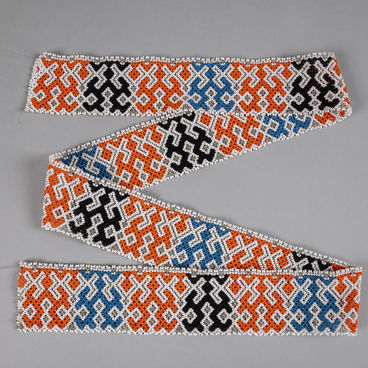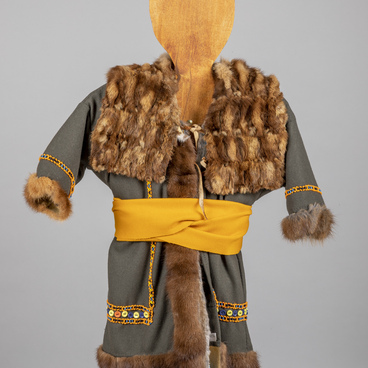Traditionally, mothers made the first cradle for their babies from a single piece of birch bark. This cradle was like a border between worlds and the birch bark drew the line that separated our world from that of the supernatural. The birch bark cradle was preserved, but not used.
After the temporary cradle served its purpose, two permanent ones were made: one was used during the day and called “hat-levan ontyp” and the other — at night and called “savun”.
The daytime wooden cradle — “hat-levan ontyp” — is made by the father from a “living” tree. He would chip away the boards of a pine or cedar tree, without touching the core, so that the tree continues to grow together with the child.
Cedar is used for the bottom and headboard, and the sides are made of birch because it bends well. The bottom tapers to the footboard. The ends of the side walls are inserted into holes located on the back of the headrest and fastened with rovduga straps (suede leather from deer skins). The upper parts of the sidewalls and the edges of the headrest feature holes for the strap. The headrest is covered with a piece of deer skin. A cross is sometimes cut out in the upper part of the headrest. Khanty believe that it protects the child from evil spirits. In such a cradle, children stay in a seated position.
The night cradle, or “savun”, is made by a woman — the child’s mother or grandmother. The night cradle has the shape of a low rectangular box made of birch bark.
Each cradle features a symbolic depiction of the “wood grouse of sleep” opposite the headrest. It was believed that sleep lives in the forest. When the grouse arrives and sees this image, it stays and the child falls asleep.
Inside a Khanty dwelling, the cradle was suspended on a hook between the bunks and the hearth, so that the child was always protected by fire. This hook was considered a talisman and passed through generations from mother to daughter. The cradle was positioned with the headrest pointing to the exit or window.
The cradle was carried through the entrance of the house with the headrest pointing forward. Passing the cradle with the child over the doorstep was not allowed. When walking, the cradle was carried on the back strapped with loops to the chest. When stopping in the forest, it was suspended from an inclined tree at a reasonable height from the ground, where there are fewer midges and no snake could crawl in. During reindeer rides, the mother put the cradle on her narty sled.
The cradle protected the child from evil spirits and served as its “micro-dwelling” for up to two or three years.
Parents tried to preserve the wooden cradle of their firstborn child, especially if the baby safely passed into childhood. Such a cradle could be passed on to the family’s adult daughter and used by more than one generation. Conversely, if the child did not survive, the cradle could no longer be used and it was taken away into the forest.





